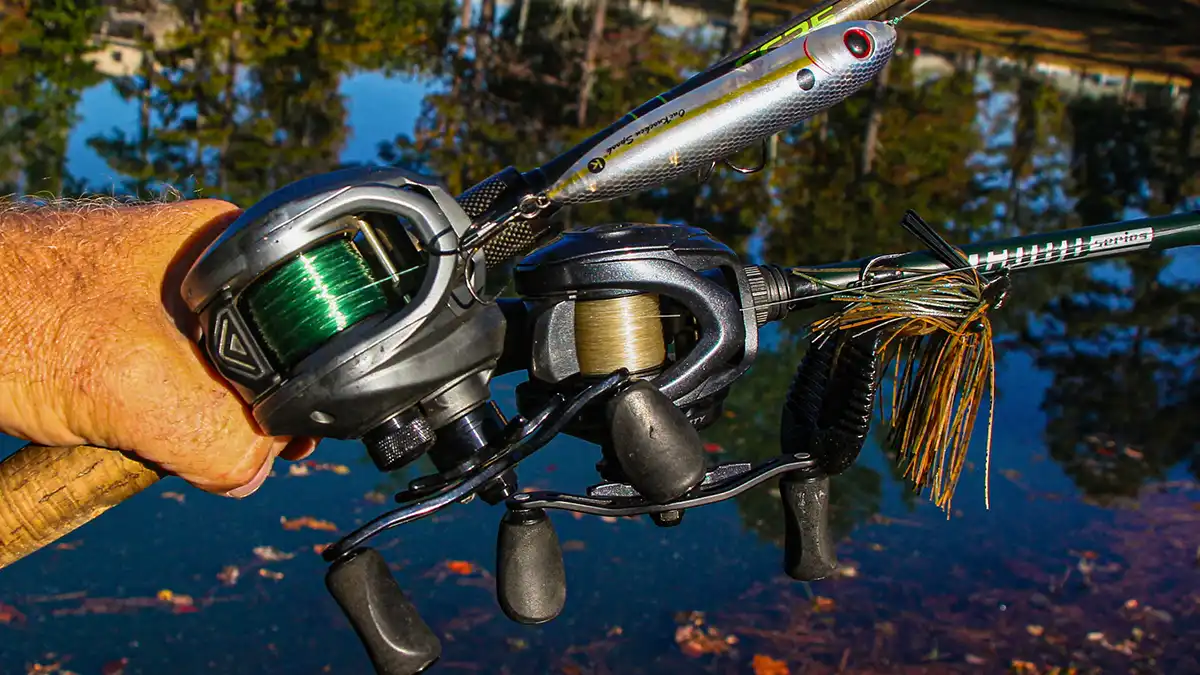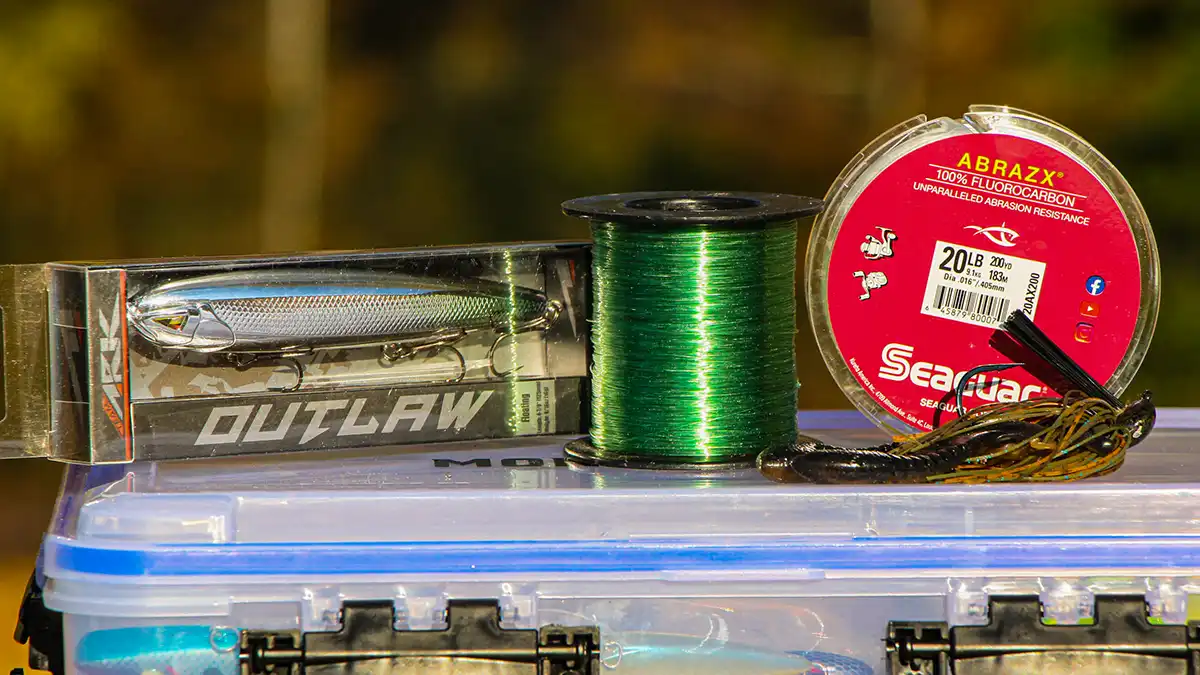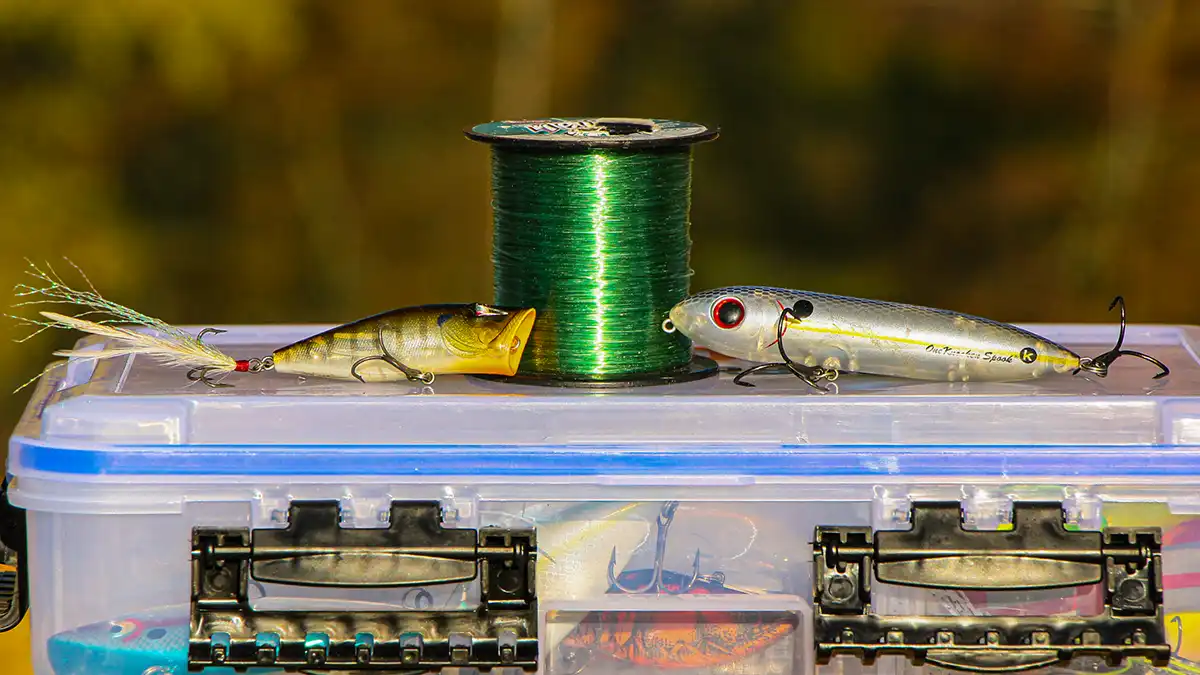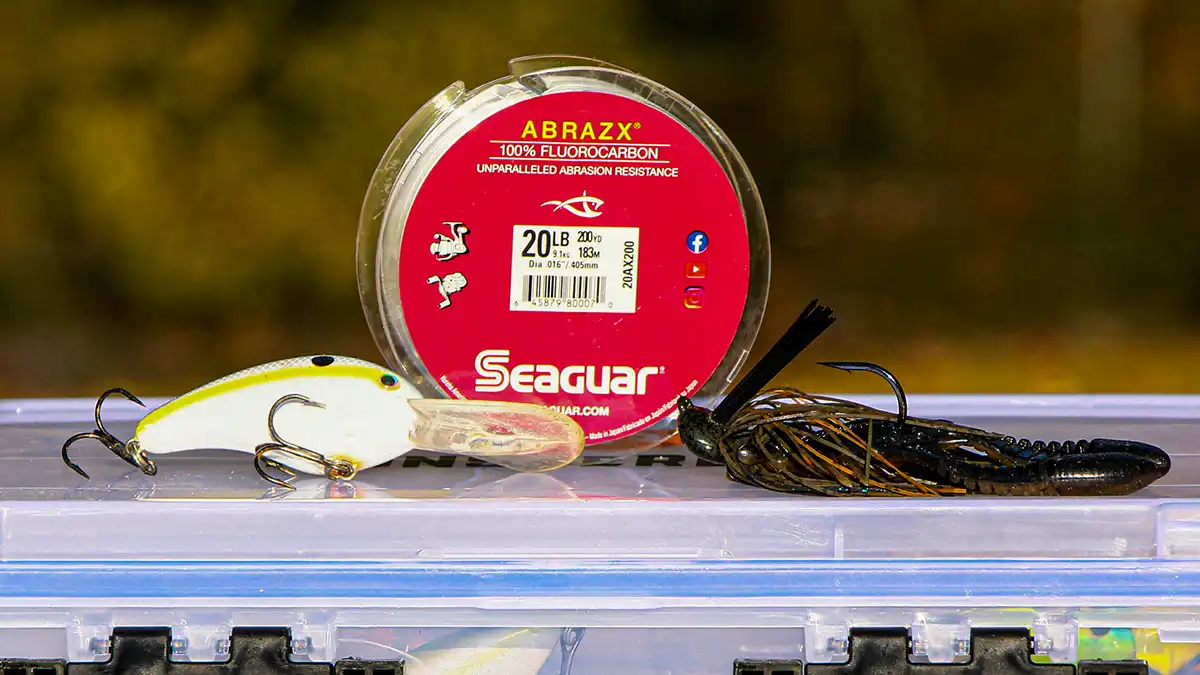Today we’re going to look at two of the three major line types for bass fishing as we discuss the similarities and differences of fluorocarbon vs monofilament fishing lines. You can fish the vast majority of bass fishing techniques with just these two line types, though there are some things you simply cannot do without braided line and others still that braid is more efficient with. But that conversation is for another day. Today, let’s look at fluorocarbon versus monofilament.
THE BASICS OF LINES
Monofilament fishing line, often referred to as “mono”, is typically made of nylon pellets extruded into a single strand of nylon. Fluorocarbon line, or “fluoro”, is made from polyvinylidene fluoride pellets that are melted down and made into a single strand. So both lines are single strands of material, but those two materials have very different attributes.
SITUATIONAL ATTRIBUTES
You’ll notice that a few of the same attributes of these lines are listed in both the pros and cons lists, like the fact that monofilament line floats. That’s because some of these pros and cons are situational. For instance, when wanting to fish a bait along the bottom, the fact that mono floats is a bad thing and will work against your presentation. But when fishing with a topwater bait, this attribute of mono is a good thing and will help keep your bait on top of the water.
The adverse is true for fluorocarbon. Because it sinks, this is a much better line for fishing baits along the bottom. But also because it sinks, you won’t want to use this line with a topwater.
It is also situational as to whether or not the stretchiness of each of these lines is a good thing. Fluoro has less stretch, so it’s better for setting the hook on single hook baits and on long casts with treble hooked baits. But the stretch of mono is acutely beneficial when fishing close quarters with a treble hook bait, as it absorbs the shock of a sudden hookset and allows the fish to fight without running the risk of tearing the hooks free.
WHEN TO USE MONO
Beginners
Monofilament is a great entry level line for anglers getting into bass fishing because it’s considerably more affordable than most fluorocarbon lines (though there are recent fluoro offerings like Basix from Seaguar that offer a quality fluoro for a more competitive price when compared to monofilament).
This line is also a little easier to cast, though the casting range is more limited because of the larger line diameters. Knots are also a little easier to tie with mono, and the knot strength is better. This takes a little more of the need for experience out of the equation, again making mono often the better selection for newcomers to the sport.
Topwaters
Mono is the better option for topwater baits primarily because it floats. If you were to try to fish a topwater bait like a Spook on fluoro, you’d have to work the bait with your rod tip up and constantly put in effort to keep the line from sinking and pulling the nose of your bait down.
The stretch of mono is also again a good thing with topwaters like poppers, when fishing them close to the boat. These baits have small hooks and the fish are often full of energy when they bite. So, the stretch of mono is very beneficial when hooking into a hard-fighting fish close the boat with small hooks.
Backing
Because of it’s affordability, mono is also a great line to use for backing on your reel. Even if you do have a presentation that fluorocarbon is better for, you’ll never need a full spool of it on a baitcaster. You can use mono to fill your reel about halfway and then use a double-uni knot (or some other line-to-line knot) to connect your monofilament backing to your fluorocarbon. Then finish spooling the reel with fluoro. In doing this, you’ll significantly cut the cost of spooling the reel as opposed to what it would have cost to use only fluoro.
Pros:
- Floats
- Higher knot strength
- More affordable
- Beginner friendly
- More stretch
- Easier to handle
Cons:
- Floats
- Less sensitivity
- Larger line diameter
- More stretch
- More prone to damage from UV light
- More memory
WHEN TO USE FLUORO
Impact Hooksets
Because of fluorocarbon’s lower stretch, higher strength with a smaller diameter, abrasion resistance, sinking characteristic and sensitivity, it’s a great line for many single hook baits like football jigs, swim jigs and Texas rigs. Mono is sufficient for setting small and thin treble hooks, but when trying to generate enough force for an impact hookset, the stretchiness of mono makes it hard to hook fish with bigger, bolder hooks.
These baits are also often fished around cover, so the more abrasion resistant fluoro wins out here too. And because many of these baits are fished several feet beneath the water’s surface, the fact that fluoro sinks allows the bait to get down deeper faster and stay there. The thinner diameter helps with this as well, as the line can cut through the water quicker than the larger diameter, equivalent pound test in mono would be able to.
Fluoro’s thinner diameter and ability to sink also helps decrease the bow in your line beneath the water, creating a more direct point of contact with the bait. In addition to fluoro already being more sensitive than mono, this vastly increases the sensitivity of your presentation as a whole, giving you the ability to maintain bottom contact better, as well as feel the differences in bottom composition and detect bites more easily.
Cranking
These same attributes also make fluoro better for mid-depth and deep-diving crankbaits. Fluoro’s thinner diameter and innate ability to sink work in favor of the presentation where the thicker mono that floats would work against it.
Using a 12-pound fluoro with a deep-diving crankbait versus a 12-pound mono adds multiple feet to the bait’s depth range, helps it reach the bottom quicker, and allows for a much longer cast. All of this means the bait will be in the strikezone longer. And because of fluoro’s better abrasion resistance, it’s less likely to be damaged as it moves through rock, wood and other cover along the bottom.
Mono can be better for some shallow cranking and small wake baits. With a wake bait, you’ll want the lure to stay right along the surface. So using a larger diameter mono that floats will help here. In the same way, a 20-pound-test mono with its larger diameter will allow you to crank a square bill through a shallow area easier than 15-pound-test fluoro would, by taking away a bit of the bait’s ability to dive.
High-pressure situations
Fluoro has less memory than monofilament and a smaller diameter, which makes it easier to use on spinning reels. And because fluoro nearly disappears beneath the water’s surface, it is a much better line for finesse techniques in high-pressure situations.
The smaller diameter for the equivalent pound test and fluoro’s added abrasion resistance also allow you to use a smaller pound test than you could with mono, making the line even harder to detect in high-visibility, high-pressure situations, such as fishing a Damiki rig or dropshot in ultra-clear water.
These high-pressure situations aren’t relegated to finesse fishing with spinning gear alone either; this is another reason why fluoro is better for flipping and bed fishing when impact hooksets already make fluoro the clear choice.
Pros:
- Less stretch
- More sensitivity
- Lower visibility
- Sinks
- More abrasion resistant
- Less prone to damage from UV light
- Smaller line diameters
- Less memory
Cons:
- Sinks
- Lower knot strength
- Harder to tie knots
- More expensive
ROUNDING OUT LINE CHOICES
Though fluorocarbon lines are becoming increasingly affordable and monofilament lines are more transparent than ever before, there are still plenty of stark differences to note when discussing fluorocarbon versus monofilament lines. Abrasion resistance, smaller line diameter and lower stretch are among key aspects that make fluorocarbon the better choice for a wide variety of baits. But the ease of use, stretch and ability to float of mono make it the better choice at times as well.
The key is to not get too bogged down in this conversation and instead perfect your craft overtime. At the end of the day, each of these lines are serviceable in many of the same situations. So don’t think you need to have 10 reels spooled up with a variety of line sizes in each line type to start with. You can do a lot with one reel spooled with either 15-pound test mono or 15-pound test fluoro, and you can fish the majority of bass fishing techniques fairly well with a combination of these two.
















